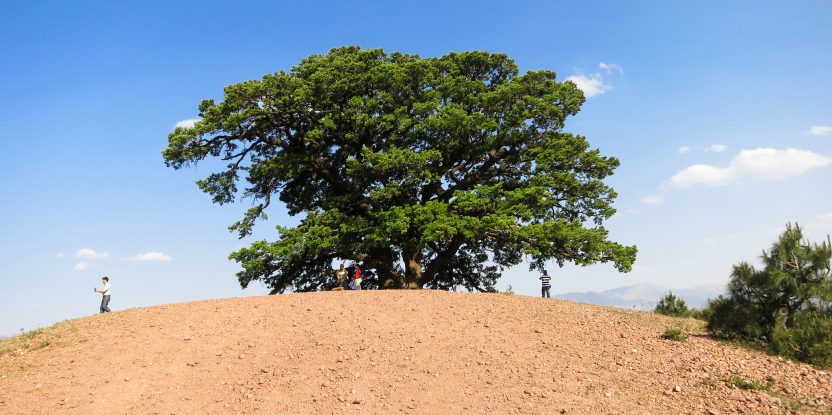
Since 1999, China has restored forest landscapes across more than 28 million hectares of farmland and land classified as barren or degraded.
As global efforts turn to restoration as a way to mitigate climate change – led by the Bonn Challenge, with the goal of restoring 150 million hectares of deforested and degraded land by 2020, and 350 million hectares by 2030 – researchers are looking to China for lessons on how to achieve this.
A major driver of China’s success has been the ‘Conversion of Cropland to Forest Program’ (CCFP), also known as ‘Grain for Green’. The program pays farmers to plant trees on their land and provides degraded land to rural families to restore.
CCFP has so far cost more than USD 40 billion, including direct payments to more than 32 million rural households. Overall, this massive program has affected the lives of 124 million people. The program is particularly important for China as 65 percent of the country’s total land area is mountainous and hilly, and a large proportion of China’s farmers live on sloping lands.
Some instructive findings have emerged from a four-year study by the Center for International Forestry Research (CIFOR) in partnership with scientists from China’s Forest Economics and Development Research Center (FEDRC). Under the research program known as SLANT – Sloping Lands in Transition – CIFOR became the first foreign organization to access data from China’s national restoration program.
“We wanted to get a better understanding of the socioeconomic and environmental benefits and impact of CCFP through its monitoring program. There is still a lot more to learn, especially about the effect of the program on a variety of ecosystem services,” says Yustina Artati, a CIFOR research officer.
RESTORING CHINA’S FORESTS
Louis Putzel, a former CIFOR scientist who led the SLANT program, says China has suffered serious consequences from deforestation in the past, and has had to implement a huge range of strategies to get trees back into the landscape.
This has included taking the approach of FLR, Forest Landscape Restoration, which aims to improve ecological functions and human well-being.
“FLR as a field has a lot to learn from China,” says Putzel.
Research collaboration through SLANT has focused on rigorous data collection and analysis, as well as support for environmental assessments. This work is helping scientists identify any research gaps, learn what works and what needs improvement.
Putzel says the development community, as well as national governments implementing reforestation projects, need to know how the approach has worked in China.
Each year, the FEDRC researchers and data investigators visit farmers annually in 21 provinces to find out firsthand the successes and also the challenges these communities face. The results can eventually help communities make more informed decisions that affect their land and livelihoods.
“We have been working with our Chinese counterparts to ensure that the data collection is the best it can be. Surveys have been done of thousands of farm families and the results can help not only China, but the global community,” says CIFOR researcher Himlal Baral.
He adds that plans are being made for further research collaboration with several other Chinese research institutions, including work with Renmin University and Beijing Forestry University on the socioeconomic and biophysical aspects of forestry, landscape restoration and climate change.
Key findings from SLANT have been shared through workshops, presentations, and key events, and of course research papers – to date, more than 70 have been published.
SHARING THE KNOW-HOW
Ethiopia is just one example of how other countries can learn from China’s success. Scientists and government forestry officials from China and Ethiopia have been brought together under the SLANT program to share experiences and find solutions to problems that can have a negative impact on reforestation programs.
Last year, Chinese researchers were able to see for themselves the challenges Ethiopia faces during a field visit and provide some FLR solutions for Ethiopia to reach its goal of restoring 15 million hectares of degraded forests.
CIFOR researchers have been working with a number of China’s national agricultural and forestry research institutes for more than 15 years, and this partnership has resulted in a rich source of information and data that can be used to improve agricultural and forestry strategies as well as rural livelihoods.
“During our long-standing collaboration with China, we have benefited from the knowledge and conceptual inputs of our Chinese colleagues on forestry-related matters as they apply in China — from bamboo enterprise value chains, to the role of forestry Chinese enterprises abroad, to more recent forest restoration,” says Robert Nasi, CIFOR’s Director General.
Nasi says this collaboration has opened the door to invaluable knowledge and data on the Chinese land restoration programs, which are among the world’s largest.
“We would like to expand to new topics with additional resources focusing on forest product value chains and forest landscape restoration considering important cross-cutting issues like tenure and climate change,” he says.
A senior delegation from China’s Academy of Agricultural Science is in Indonesia this week to discuss a new research partnership with the Center for International Forestry Research (CIFOR) at its headquarters in Bogor.
We want you to share Forests News content, which is licensed under Creative Commons Attribution-NonCommercial-ShareAlike 4.0 International (CC BY-NC-SA 4.0). This means you are free to redistribute our material for non-commercial purposes. All we ask is that you give Forests News appropriate credit and link to the original Forests News content, indicate if changes were made, and distribute your contributions under the same Creative Commons license. You must notify Forests News if you repost, reprint or reuse our materials by contacting forestsnews@cifor-icraf.org.